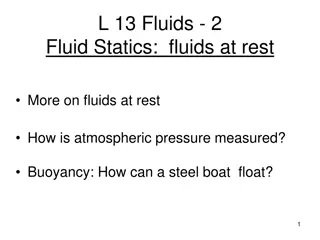Principles of Atmospheric Flight in Aeronautics
This material covers essential topics in aeronautics including the physical properties of the atmosphere, standard atmosphere relationships, Mach number theory, lift and drag principles, stability, control, pressure and temperature variations based on location and solar activity, and the International Standard Atmosphere model. Understanding altitude, pressure altitude, density altitude, and their significance in aircraft performance is emphasized.
Download Presentation

Please find below an Image/Link to download the presentation.
The content on the website is provided AS IS for your information and personal use only. It may not be sold, licensed, or shared on other websites without obtaining consent from the author.If you encounter any issues during the download, it is possible that the publisher has removed the file from their server.
You are allowed to download the files provided on this website for personal or commercial use, subject to the condition that they are used lawfully. All files are the property of their respective owners.
The content on the website is provided AS IS for your information and personal use only. It may not be sold, licensed, or shared on other websites without obtaining consent from the author.
E N D
Presentation Transcript
Subject Name : ELEMENTS OF AERONAUTICS Subject Code : 10AE45 Prepared By : SARATH P MOHAN Department : AERONAUTICAL Unit : 3-PRINCIPLES OF ATMOSPHERIC FLIGHT
UNIT 2 TOPICS COVERED PHYSICAL PROPERTIES AND STRUCTURE OF THE ATMOSPHERE THE STANDARD ATMOSPHERE TEMPERATURE, PRESSURE AND ALTITUDE RELATIONSHIP MACH NUMBER THEORY OF LIFT AND DRAG CONCEPT OF STABILITY AND CONTROL
Standard atmosphere Pressure and temperature depends on Location on globe(longitude and latitude) Season Solar sunspot activity(radiation)
International Standard atmosphere A standard atmosphere is defined in order to relate flight tests, wind tunnel results and general airplane design and performance to common reference. International Standard Atmosphere: The International Standard Atmosphere (ISA) is an atmospheric model of how the pressure, temperature, density, and viscosity of the Earth's atmosphere change over a wide range of altitudes or elevations. It has been established to provide a common reference for temperature and pressure and consists of tables of values at various altitudes, plus some formulas by which those values were derived
Temperature distribution in the standard atmosphere
Altitude Absolute altitude Geometric Geo potential Pressure Density altitude True altitude Indicate altitude
Altitude Geometric height above sea level-geometric altitude Height is measured from center of earth absolute altitude
Pressure altitude Pressure altitude is the elevation above a standard datum air-pressure plane (typically, 1013.25 millibars or 29.92" Hg). Pressure altitude and indicated altitude are the same when the altimeter setting is 29.92" Hg or 1013.25 millibars.
Density altitude Density altitude is the altitude corrected for non-ISA International Standard Atmosphere atmospheric conditions. Aircraft performance depends on density altitude, which is affected by barometric pressure, humidity and temperature. On a very hot day, density altitude at an airport (especially one at a high elevation) may be so high as to preclude takeoff, particularly for helicopters or a heavily loaded aircraft. Density altitude is a yardstick by which we can reference the "density" of air. Air density is a measure of the number of gas molecules (nitrogen, oxygen, etc., whatever we've got in our atmosphere) within a given volume of space. We care about the density of air because our wings and prop use these air molecules to generate lift and thrust, and because our engine needs oxygen for combustion. As density decreases (i.e. density altitude increases), our engines generate less power because they have less oxygen to mix with fuel and burn, and our wings and prop generate less lift, so we accelerate slower and have higher stall speeds. This means longer takeoff and landing runs, and slower climbs.
Relation between geo potential height and geometric height Newton s gravitational law implicates: g= g0(r/ha)2= g0(r/r+hg)2 The hydrostatic equation is: dp = gdhg However, g is variable here for different heights. Since a variable gravitational acceleration is difficult to work with, the geopotential height h has been introduced such that: So this means that: dh= (g/go )dhg = r2/(r+hg)2 dhg And integration gives the general relationship between geopotential height and geometric height: h= (r/r+hg) hg dp = godh (2.1) (2.2)
Relations between pressure, density and height (i) The famous equation of state is: p = RT (3.1) Dividing the hydrostatic equation (2.1) by the equation of state (3.1) gives as results: dp/p =- g0dh/ RT =-(go/RT)dh If we assume an isothermal environment (the temperature stays the same), then integration gives: Solving this gives the following equation:
Relations between pressure, density and height (ii) And combining this with the equation of state gives the following equation:
Relations between pressure, density and temperature We now again divide the hydrostatic equation (2.1) by the equation of state (3.1), but this time we don t assume an isothermal environment, but we substitute dh = in it, to get: Integration gives: Which is a nice formula. But by using the equation of state, we can also derive the following:
Lift and drag Lift and drag Drag is a component of the aerodynamic force, namely the projection onto the direction parallel to the relative wind. Lift is another component of the aerodynamic force, namely the projection onto the two directions perpendicular to the relative wind.
Mach number The ratio of the speed of the aircraft to the speed of sound in the gas determines the magnitude of many of the compressibility effects. Because of the importance of this speed ratio, aerodynamicists have designated it with a special parameter called the Mach number
Mach number If the mach number is <0.8, the flow speed is lower than the speed of sound - and the speed is subsonic. If the mach number is between 0.8 1.2, the flow speed is approximately like the speed of sound - and the speed is transonic. If the mach number is between 1.2 5.0, the flow speed is higher than the speed of sound - and the speed is supersonic. If the mach number is between 5.0 10.0, the flow speed is much higher than the speed of sound - and the speed is hypersonic.
Stability and control Stability: It is the study of how an aircraft responds to small disturbance in flight and how it can designed so that it remains at a fixed incidence and speed without overworking the pilot Control: It refers to the ability to initiate and sustain changes in angle of attack
Stability and control If the aircraft continues to increase the orientation after disturbance, the aircraft is said to be statically unstable. If there are no further changes in flight attitude and if the aircraft retains the position, which means there are no net forces or moments acting on the aircraft in the new orientation too, then the aircraft is said to be statically neutral. If forces are generated on the aircraft in a way such that forces causing the disturbance are countered, and the aircraft attains its original position, then the aircraft is said to be statically stable.
Dynamic stability If an aircraft is statically stable, it may undergo three types of oscillatory motion during flight. When imbalance occurs the airplane attempts to retain its position, and it reaches the equilibrium position through a series of decaying oscillations, and the aircraft is said to be dynamically stable. If the aircraft continues the oscillatory motion without decay in the magnitude, then the aircraft is said to be on dynamically neutral. If the magnitude oscillatory motion increases and the aircraft orientation start to change rapidly, then the aircraft is said to be dynamically unstable.























